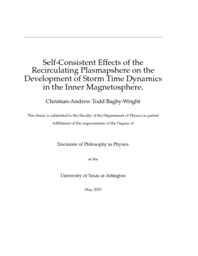| dc.description.abstract | The near Earth space environment is a highly coupled system. The Interplanetary Magnetic Field (IMF) interacts with the magnetosphere in myriad ways depend on the orientation of the IMF to the magnetosphere. The magnetic fields of the magnetosphere and the IMF trap plasma and carry the plasma with it as both magnetic fields evolve over time. This plasma can in turn interact with other plasmas, carried by other field lines, affecting the dynamics of the other population and the magnetic field lines of both populations. The nature, frequency, and importance of interactions between different plasma, or magnetic fields, varies greatly depending on things such as the density of the plasma, strength of the magnetic field, or relative energies of the plasmas. The study of these many varied and recursive relationships is called magnetohydrodynamics (MHD). The plasmasphere is a population of cold and dense plasma near Earth, which often goes understudied due to its typically sedentary nature.
The fate of plasmasphere material once it is drained out of the plasmasphere through a plume and into the solar wind or plasma mantle is unknown. One of two things may happen to the eroded plasmasphere material. It can be swept away with the solar wind, lost to the Earth system, or it may be recaptured by reconnection on the night side of the planet, and transported through the plasma sheet into the inner magnetosphere. Recirculating plasmasphere material which has been recaptured could plausible contribute to the ring current.
Using observations to study the fate of the plasmasphere is difficult, as space plasma is mostly hydrogen. The homogeneity of the plasma species complicates identifying source populations of a plasma with in situ observations. Numerical models however, can keep the material distinct, opening the possibility of resolving the question using simulations.
This work was completed in two major parts. The first part uses numerical models to answer two questions: First, does any plasmasphere material recirculate back into the magnetosphere? Second, what signature can we look for in real world data to distinguish if this is a physical or model effect? This is done by studying simulations produced by the Space Weather Modeling Framework (SWMF) configured to couple three models: the Block Adaptive Tree Solar Roe Up Wind Scheme (BATS-R-US) model, the Dynamic Global Core Plasma Model (DGCPM) plasmasphere model, and the Ridley Ionosphere Model (RIM). For these simulations BATS-R-US is configured to use two fluids. The first fluid represents currently accepted sources of ring current material, namely the solar wind and high latitude ionospheric outflow (polar wind). The second fluid represents the plasmasphere. Within 10 Earth Radii (R\subscript{E}) the dynamics of the second BATS-R-US fluid on closed field lines is dictated by coupling with the DGCPM. DGCPM passes the density of material in the plasmasphere to BATS-R-US. In addition to this coupling, RIM passes electric field information to both BATS-R-US and DGPCM while receiving current density form BATS-R-US. This configuration of the SWMF represents a novel advancement in simulations of the plasmasphere, more self-consistent then previous studies. To study how plasmasphere material recirculates and how it might affect the ring current two simulations are run: including an Idealized Square Wave Event and an Idealized Corotating Interaction Region Event.
The second part consists of altering the configuration of the SWMF and integrated models to enhance our ability to explore plasmasphere recirculation. I place a particular emphasis on integrating a ring current model. The integration of a ring current model would allow use to self-consistently study the effects of the recirculating plasmasphere on key metrics of storm strength such as D\subscript{st}. This is done by studying simulations produced by the SWMF configured to couple three models: BATS-R-US, the Comprehensive Inner Magnetosphere-Ionosphere (CIMI) model, and RIM. BATS-R-US is again configured to use two fluids. The first fluid represents currently accepted sources of ring current material, namely the solar wind and polar wind. The second fluid represents the plasmasphere. Within 10 R\subscript{E} the dynamics of the plasmasphere fluid in BATS-R-US on closed field lines are dictated by coupling with CIMI. In a new capability added to CIMI for this study, BATS-R-US passes density and pressure information to two populations in CIMI. Previously CIMI had only one population to represent plasma at its outer boundary. We have added a second population representing the portion of the plasmasphere which has recirculated which contributes directly to ring current material. With this new capability, we can see exactly what portion of observables such as density, momentum, and pressure or D\subscript{st} comes from the recirculating plasmasphere material. CIMI then couples back to BATS-R-US by passing the total density of material in the plasmasphere to the MHD plasmasphere fluid, as well as the pressure of the ring current and radiation belt. In addition to this coupling, RIM passes electric field information to both BATS-R-US and CIMI while receiving current density from BATS-R-US. This configuration has the advantage of an integrated ring current model over the above configuration of the SWMF. This allows us to self-consistently model the ring current while maintaining the advantage of being able to distinguish how much each population contributes to the total ring current. While I do not presented conclusive results of simulations conducted with such a configuration, I will discuss model development, verification, and the current state of the effort. | |


